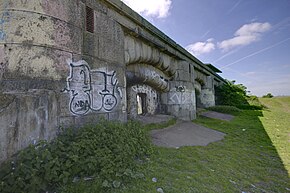Shornemead Fort
| Shornemead Fort | |
|---|---|
| close to Higham, Kent | |

View of the exterior of the casemates of Shornemead Fort
|
|
| Coordinates | 51°26′48″N 0°26′03″E / 51.446768°N 0.434059°E |
| Type | Fortification |
| Site information | |
| Controlled by | Royal Society for the Protection of Birds |
| Open to the public |
Yes |
| Condition | Mostly demolished |
| Site history | |
| Built | ca. 1861–70 |
| Built by | United Kingdom |
| In use | 1870–1950s |
| Materials | Concrete, granite |
| Demolished | 1960s |
| Battles/wars | First World War, Second World War |
Shornemead Fort is a now-disused artillery fort that was built in the 1860s to guard the entrance to the Thames from seaborne attack. Constructed during a period of tension with France, it stands on the south bank of the river at a point where the Thames curves sharply north and west, giving the fort long views up and downriver in both directions. It was the third fort constructed on the site since the 18th century, but its location on marshy ground led to major problems with subsidence. The fort was equipped for a time with a variety of large-calibre artillery guns which were intended to support two other nearby Thamesside forts. However, the extent of the subsidence meant that it became unsafe for the guns to be fired and the fort was disarmed by the early 20th century.
Shornemead Fort was in use from its completion in 1870 to its abandonment in the 1950s. Much of it was demolished by the Army Demolition School of the Royal Engineers in the 1960s. The barracks and administrative buildings have been completely destroyed and only the front of the casemates survives along with the magazines underneath, though the latter are now flooded and inaccessible. The surviving fragments of the fort and the area around it are part of a nature reserve and can be visited by the public.
The Thames was guarded by a number of forts built around Gravesend and Tilbury in the 16th and 17th centuries but these were inadequate against the threat of the new generation of artillery that had emerged by the end of the 18th century. An artillery battery was established farther downriver at Shornemead in 1795–96, during the Napoleonic Wars, along with two other batteries at Lower Hope Point on the Kent side and Coalhouse Point on the Essex side. It was a small pentagonal structure with earthen ramparts, within which four 24-pdr. guns were mounted in open emplacements, with a range of 2.3 km (1.4 mi). The first Shornemead Fort was provided with a barracks, magazine and defensible gorges and was planted with walnut trees nearby to supplement the garrison's food supply and provide wood for the stocks of their muskets.
After the defeat of Napoleon the battery was abandoned. It was rebuilt in the mid-1840s, along with Coalhouse Fort. The second Shornemead Fort was constructed between 1848–52 to a polygonal plan inspired by the ideas of the French military engineer Montalembert, in a novel move away from the bastioned trace design used in other British forts of the time. It was an open battery like the first fort, but with much more numerous and powerful artillery – thirteen 32-pdr. guns on traversing carriages, each with a range of 2.7 km (1.7 mi). The ramparts occupied three sides of the fort, facing the river. A barracks was constructed on the remaining two (landward) sides, along with bomb-proof magazines and defensive caponiers to flank the fort's ditch. The marshy ground caused major problems and the fort was not completed until 1853. Subsidence badly cracked the cookhouse and barracks, and one of the caponiers split away from the rest of the structure.
...
Wikipedia

